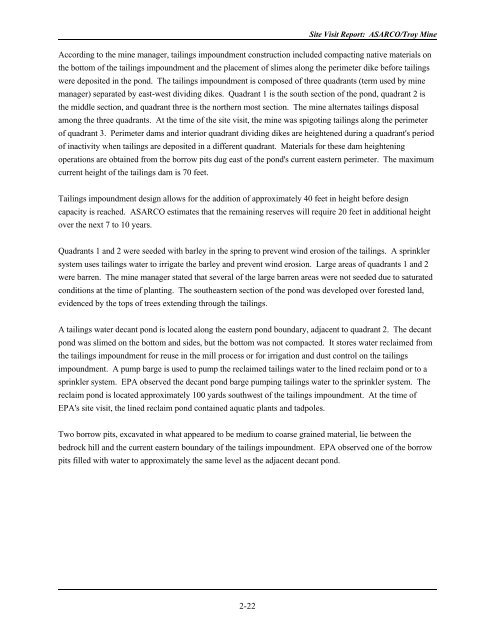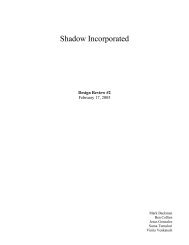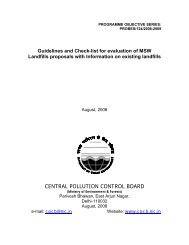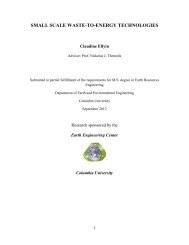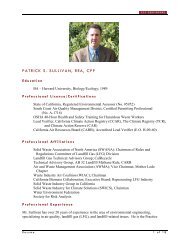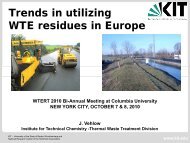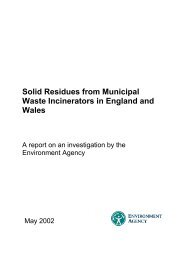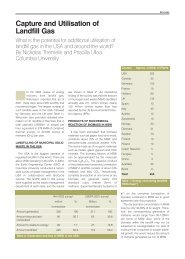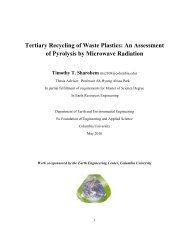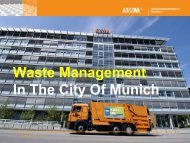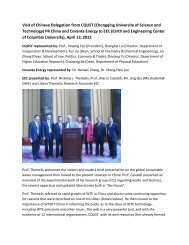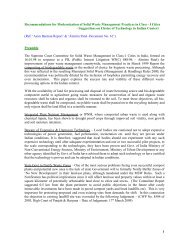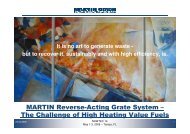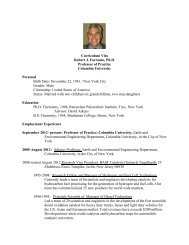- Page 1 and 2:
EPA 530-R-94-031NTIS PB94-200979TEC
- Page 3 and 4:
TABLE OF CONTENTSTechnical Resource
- Page 5 and 6:
Technical Resource Document: Copper
- Page 7 and 8:
Technical Resource Document: Copper
- Page 9 and 10:
Mining Industry Profile: Copper1.0
- Page 11 and 12:
Mining Industry Profile: Copper1.2
- Page 13 and 14:
Mining Industry Profile: Copper. By
- Page 15 and 16:
Mining Industry Profile: CopperTabl
- Page 17 and 18:
Mining Industry Profile: CopperSedi
- Page 19 and 20:
Mining Industry Profile: Copper1.4
- Page 21 and 22:
Mining Industry Profile: CopperFigu
- Page 23 and 24:
Mining Industry Profile: CopperFigu
- Page 25 and 26:
Mining Industry Profile: CopperBloc
- Page 27 and 28:
Mining Industry Profile: Copper) is
- Page 29 and 30:
Mining Industry Profile: Copper(Sou
- Page 31 and 32:
Mining Industry Profile: CopperFigu
- Page 33 and 34:
Mining Industry Profile: Copperdiff
- Page 35 and 36:
Mining Industry Profile: CopperFigu
- Page 37 and 38:
Mining Industry Profile: CopperFigu
- Page 39 and 40:
Mining Industry Profile: Copperpart
- Page 41 and 42:
Mining Industry Profile: CopperFigu
- Page 43 and 44:
Mining Industry Profile: Copperutil
- Page 45 and 46:
Mining Industry Profile: CopperIoni
- Page 47 and 48:
Mining Industry Profile: CopperMech
- Page 49 and 50:
Mining Industry Profile: Copper) in
- Page 51 and 52:
Table 1-4. Characteristics of Coppe
- Page 53 and 54:
Mining Industry Profile: CopperFor
- Page 55 and 56:
Mining Industry Profile: CopperFigu
- Page 57 and 58:
Mining Industry Profile: Coppersumm
- Page 59 and 60:
Mining Industry Profile: Copper(Sou
- Page 61 and 62:
1-53Mining Industry Profile: Copper
- Page 63 and 64:
Mining Industry Profile: CopperDump
- Page 65 and 66:
Mining Industry Profile: Copper.In
- Page 67 and 68:
Mining Industry Profile: CopperFigu
- Page 69 and 70:
Mining Industry Profile: CopperUnde
- Page 71 and 72:
Mining Industry Profile: Copperelec
- Page 73 and 74:
Mining Industry Profile: CopperFigu
- Page 75 and 76:
Mining Industry Profile: CopperTher
- Page 77 and 78:
Mining Industry Profile: Copper(Sou
- Page 79 and 80:
Mining Industry Profile: CopperThe
- Page 81 and 82:
Mining Industry Profile: Copper1.5
- Page 83 and 84:
Mining Industry Profile: Copperiden
- Page 85 and 86:
Mining Industry Profile: CopperIn t
- Page 87 and 88:
Mining Industry Profile: CopperSpen
- Page 89 and 90:
Mining Industry Profile: CopperFigu
- Page 91 and 92:
Mining Industry Profile: Copperthe
- Page 93 and 94:
Mining Industry Profile: CopperSolu
- Page 95 and 96:
Mining Industry Profile: Copper1.6
- Page 97 and 98:
Mining Industry Profile: Copperrecy
- Page 99 and 100:
Mining Industry Profile: CopperAMD
- Page 101 and 102:
Mining Industry Profile: Copperthro
- Page 103 and 104:
Mining Industry Profile: CopperAmen
- Page 105 and 106:
Mining Industry Profile: CopperTabl
- Page 107 and 108:
Mining Industry Profile: CopperSome
- Page 109 and 110:
Mining Industry Profile: CopperBLM'
- Page 111 and 112:
Mining Industry Profile: CopperAlth
- Page 113 and 114:
Mining Industry Profile: CopperThe
- Page 115 and 116:
Mining Industry Profile: Copperimpo
- Page 117 and 118:
Mining Industry Profile: Copper1.8
- Page 119 and 120:
Mining Industry Profile: CopperGray
- Page 121 and 122:
Mining Industry Profile: CopperSout
- Page 123 and 124:
Mining Industry Profile: CopperU.S.
- Page 125 and 126:
Mining Industry Profile: CopperU.S.
- Page 127 and 128:
Comments on the Draft Industry Prof
- Page 129 and 130:
Mining Industry Profile: CopperAPPE
- Page 131 and 132:
Mining Industry Profile: Copper(Sou
- Page 133 and 134:
Mining Industry Profile: Copperpyri
- Page 135 and 136:
Mining Industry Profile: CopperTabl
- Page 137 and 138:
Mining Industry Profile: CopperTabl
- Page 139 and 140:
Mining Industry Profile: Copperpres
- Page 141 and 142:
Mining Industry Profile: CopperRuno
- Page 143 and 144:
Mining Industry Profile: Copper(Sou
- Page 145 and 146:
Mining Industry Profile: CopperMine
- Page 147 and 148:
Mining Industry Profile: CopperHeap
- Page 149 and 150:
Mining Industry Profile: Copperfrom
- Page 151 and 152:
3. Cyprus Sierrita Corporation; Sie
- Page 153 and 154:
Mining Industry Profile: Copperand
- Page 155 and 156:
Mining Industry Profile: CopperDump
- Page 157 and 158:
Mining Industry Profile: CopperAll
- Page 159 and 160:
Mining Industry Profile: CopperAcco
- Page 161 and 162:
Mining Industry Profile: CopperDuri
- Page 163 and 164:
Mining Industry Profile: CopperFigu
- Page 165 and 166:
Mining Industry Profile: CopperAfte
- Page 167 and 168:
Mining Industry Profile: Copper5. M
- Page 169 and 170:
Mining Industry Profile: CopperBene
- Page 171 and 172:
Mining Industry Profile: Copperthro
- Page 173 and 174:
Mining Industry Profile: CopperFigu
- Page 175 and 176: Mining Industry Profile: CopperSpri
- Page 177 and 178: Mining Industry Profile: CopperLeac
- Page 179 and 180: Mining Industry Profile: Copper.In
- Page 181 and 182: Mining Industry Profile: CopperEvap
- Page 183 and 184: Mining Industry Profile: CopperFigu
- Page 185 and 186: Mining Industry Profile: CopperThis
- Page 187 and 188: Mining Industry Profile: Copper(Sou
- Page 189 and 190: Mining Industry Profile: CopperVat
- Page 191 and 192: Mining Industry Profile: CopperAbou
- Page 193 and 194: Mining Industry Profile: Copper1. S
- Page 195 and 196: Mining Industry Profile: CopperWhen
- Page 197 and 198: Mining Industry Profile: CopperThe
- Page 199 and 200: Mining Industry Profile: CopperAPPE
- Page 201 and 202: Mining Industry Profile: CopperAPPE
- Page 203 and 204: Mining Industry Profile: CopperACRO
- Page 205 and 206: Site Visit Report: ASARCO/Troy Mine
- Page 207 and 208: Site Visit Report: ASARCO/Troy Mine
- Page 209 and 210: Site Visit Report: ASARCO/Troy Mine
- Page 211 and 212: Site Visit Report: ASARCO/Troy Mine
- Page 213 and 214: Site Visit Report: ASARCO/Troy Mine
- Page 215 and 216: Site Visit Report: ASARCO/Troy Mine
- Page 217 and 218: Site Visit Report: ASARCO/Troy Mine
- Page 219 and 220: Site Visit Report: ASARCO/Troy Mine
- Page 221 and 222: Site Visit Report: ASARCO/Troy Mine
- Page 223 and 224: Site Visit Report: ASARCO/Troy Mine
- Page 225: Site Visit Report: ASARCO/Troy Mine
- Page 229 and 230: Site Visit Report: ASARCO/Troy Mine
- Page 231 and 232: Site Visit Report: ASARCO/Troy Mine
- Page 233 and 234: Site Visit Report: ASARCO/Troy Mine
- Page 235 and 236: Site Visit Report: ASARCO/Troy Mine
- Page 237 and 238: Site Visit Report: ASARCO/Troy Mine
- Page 239 and 240: Site Visit Report: ASARCO/Troy Mine
- Page 241 and 242: Site Visit Report: ASARCO/Troy Mine
- Page 243 and 244: Site Visit Report: ASARCO/Troy Mine
- Page 245 and 246: Site Visit Report: San Manuel Facil
- Page 247 and 248: Site Visit Report: San Manuel Facil
- Page 249 and 250: Site Visit Report: San Manuel Facil
- Page 251 and 252: Site Visit Report: San Manuel Facil
- Page 253 and 254: Site Visit Report: San Manuel Facil
- Page 255 and 256: Site Visit Report: San Manuel Facil
- Page 257 and 258: Figure 3-3. San Manuel Tailings Imp
- Page 259 and 260: Site Visit Report: San Manuel Facil
- Page 261 and 262: Site Visit Report: San Manuel Facil
- Page 263 and 264: Site Visit Report: San Manuel Facil
- Page 265 and 266: Site Visit Report: San Manuel Facil
- Page 267 and 268: Site Visit Report: San Manuel Facil
- Page 269 and 270: Site Visit Report: San Manuel Facil
- Page 271 and 272: Site Visit Report: San Manuel Facil
- Page 273 and 274: Site Visit Report: San Manuel Facil
- Page 275 and 276: Site Visit Report: San Manuel Facil
- Page 277 and 278:
Site Visit Report: San Manuel Facil
- Page 279 and 280:
Site Visit Report: San Manuel Facil
- Page 281 and 282:
Site Visit Report: San Manuel Facil
- Page 283 and 284:
Site Visit Report: San Manuel Facil
- Page 285 and 286:
Site Visit Report: San Manuel Facil
- Page 287 and 288:
Site Visit Report: San Manuel Facil
- Page 289 and 290:
Site Visit Report: San Manuel Facil
- Page 291 and 292:
Site Visit Report: San Manuel Facil
- Page 293 and 294:
Site Visit Report: San Manuel Facil
- Page 295 and 296:
Site Visit Report: San Manuel Facil
- Page 297 and 298:
Site Visit Report: San Manuel Facil
- Page 299 and 300:
Site Visit Report: San Manuel Facil
- Page 301 and 302:
Site Visit Report: San Manuel Facil
- Page 303 and 304:
Table 3-4. Environmental Permits fo
- Page 305 and 306:
Site Visit Report: San Manuel Facil
- Page 307 and 308:
Site Visit Report: San Manuel Facil
- Page 309 and 310:
Site Visit Report: San Manuel Facil
- Page 311 and 312:
Site Visit Report: San Manuel Facil
- Page 313 and 314:
Site Visit Report: San Manuel Facil
- Page 315 and 316:
Site Visit Report: Copper Range Com
- Page 317 and 318:
Site Visit Report: Copper Range Com
- Page 319 and 320:
Site Visit Report: Copper Range Com
- Page 321 and 322:
Figure 4-2. Geologic Cross Section
- Page 323 and 324:
Site Visit Report: Copper Range Com
- Page 325 and 326:
Site Visit Report: Copper Range Com
- Page 327 and 328:
Site Visit Report: Copper Range Com
- Page 329 and 330:
Site Visit Report: Copper Range Com
- Page 331 and 332:
Site Visit Report: Copper Range Com
- Page 333 and 334:
Site Visit Report: Copper Range Com
- Page 335 and 336:
Site Visit Report: Copper Range Com
- Page 337 and 338:
Site Visit Report: Copper Range Com
- Page 339 and 340:
Site Visit Report: Copper Range Com
- Page 341 and 342:
Site Visit Report: Copper Range Com
- Page 343 and 344:
Site Visit Report: Copper Range Com
- Page 345 and 346:
Site Visit Report: Copper Range Com
- Page 347 and 348:
Site Visit Report: Copper Range Com
- Page 349 and 350:
Site Visit Report: Copper Range Com
- Page 351 and 352:
Site Visit Report: Copper Range Com
- Page 353 and 354:
Site Visit Report: Copper Range Com
- Page 355 and 356:
Site Visit Report: Copper Range Com
- Page 357 and 358:
Site Visit Report: Copper Range Com
- Page 359 and 360:
4.5 BIBLIOGRAPHY AND REFERENCESSite
- Page 361 and 362:
Site Visit Report: Copper Range Com
- Page 363:
Site Visit Report: Copper Range Com


